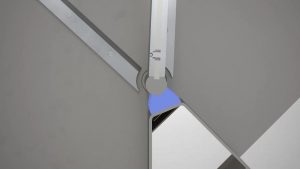
Client:
Quantity:
Size:
Application:
In February 2018, Ball Sales & Engineering – a Vortex equipment representative based in Huntington Beach, California, USA – was approached with a unique multi-port diverting opportunity. An engineer from Ball Sales and a Vortex application engineer traveled on-site to visit with a pet food manufacturer who has been a long-time client. In that visit, the client expressed a need to redesign a process within their system, in order to achieve a reduced footprint.
The Process: Storing Additives Separately Using Common Convey Lines
To begin their process, two bulk bag unloading stations are used to introduce various additives into two separate systems. Those additives include soy flakes, cellulose, pea fiber, mineral PX, potassium chloride, salt, calcium carbonate, monocalcium dical, lysine, beet pulp, sugar, and soy concentrate. Because there is a total of 12 additives, each station processes 6 additives, and each additive is introduced into the system separately. Upon entering the system, an additive is pneumatically conveyed into a vented bin before being gravity discharged through an airlock. Below the airlock, six surge bins are used to store each additive separately. Upon passing through the airlock, an additive is diverted into its appropriate surge bin. Before introducing a new additive, the convey line is purged of residual materials. Therefore, though six additives are processed through a common convey line, they are not combined at this stage in production.

The Solution: Vortex Multi-Port Diverter
For this application, the client's primary concerns were:
- Stack-up height in a limited space installation;
- Creating a minimal footprint with no line extensions, so that multiple additives can be handled in a common process; and
- Inspection/maintenance features.
Application:
- Gravity conveyance
- Material temperatures up to 120° F | 50° C
- Processing speeds: 500 – 625 PPM
- Indoor installation

With these specifications in mind, Ball Sales recommended a Vortex Multi-Port Diverter. To meet the application requirements, these Multi-Port Diverters were modified to use Vortex Seal Tite Diverters. This is unlike typical Vortex Multi-Port Diverters, which are often constructed using Vortex Wye Line Diverters.
For Vortex, the primary challenge was stack-up height in the limited space installation. More specifically, space was needed to adequately distance the multiple Seal Tite Diverters used to make up the Multi-Port Diverter, so that they could properly route to their respective surge bins while maintaining their angle of repose, to allow optimal flow rates.
Typically, process engineers would vertically stack two straight leg (K-style) flap diverters to create a 3-way flap diverter configuration. A pitfall to this configuration is it significantly adds to overall stack-up height. With this issue in mind, Vortex has developed a three-way Seal Tite Diverter – of which several were used in this Multi-Port configuration. The primary benefit of a three-way diverter is that it integrates what would be a need for two diverters into a single unit, which significantly reduces
overall stack-up height.

To meet the client’s requirements, each Multi-Port Diverter was assembled using:
- (Qty. 1) two-way Seal Tite Diverter with a symmetrical (A-style) design and square outlet transition chutes constructed from carbon steel. The purpose of the transition chutes is to extend the diverter's outlet legs, to make clearance for the three-way diverters below.
- (Qty. 2) three-way Seal Tite Diverters
Specifications:
- (Qty. 2) Vortex Multi-Port Diverters
- Diverter Sizes: 8 in | 205 mm
- Diverter bodies and flapper blades constructed from carbon steel.
- Material contact areas constructed from carbon steel, polymer, and white
Buna-N nitrile rubber. - Outlet legs angled 30° from vertical.
- Air cylinder actuators built with magnetic pistons, to accommodate magnetic reed switches for blade position indication.
- Support frame constructed from painted carbon steel. The frame’s purpose is to support the multi-port structure and assist installation as a cohesive unit.
- Full unit to be painted white, per customer preference.
- Supplied with magnetic reed switches, vented ball valves, quick-dump exhaust valves (for faster actuation) with mufflers (to reduce noise), and NEMA 4-rated air control solenoids.

Both Multi-Port Diverters were also supplied with a pre-wired terminal box. Each terminal box consists of:
- Double-coil solenoids (Qty. 5: 1 for the 2-way diverter & 2 for each 3-way diverter)
- Manifold-mounted
- Plumbed inside box
- NEMA 4-rated terminal box constructed from stainless steel. Rated for Class II, Div 2, Group G (explosion-proof)
As a safeguard in case of an upset condition or if maintenance is required downstream, the client also required two Vortex Maintenance Gates, to be installed above both airlocks.
Features:

The Vortex Seal Tite Diverter is designed with:
- A removable access panel that allows access to the diverter’s interior for inspection, cleaning and/or maintenance. These processes can be performed while the diverter remains in-line. (Figure 1)
- The leading edge of the flapper blade actuates into a recessed area that protects it from the material flow stream. This design protects the blade’s leading edge and seals from wear as materials pass through the valve. Otherwise, seal wear could allow material leakage into the opposite legs. (Figure 2)
- A live-loaded, wear-compensating seal beneath the blade shaft to prevent material migration into the opposite legs. The shaft seal also fills the void beneath the blade shaft to prevent materials from collecting there, which could otherwise cause actuation issues and concerns for contamination and spoilage.

- The shaft seal is constructed from hard polymer and is “live-loaded” with compressed rubber backing. As the polymer experiences frictional wear from many actuations over time, the compressed rubber backing continuously forces the shaft seal upward against the blade shaft. This design allows the blade shaft to maintain its seal of materials over time with infrequent maintenance intervention.
(Figure 3)













